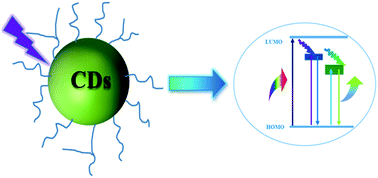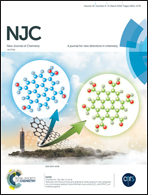Origin of green luminescence in carbon quantum dots: specific emission bands originate from oxidized carbon groups†
Abstract
As a newly developed fluorescent material, carbon dots (CDs) have exhibited promising potentials in bioimaging and light-emitting diodes (LEDs); however, the luminescence origins are still ambiguous. Herein, we propose the surface states associated with carboxyl and carbonyl functional groups for radiative transitions in the green waveband originating from CDs according to comprehensive analyses on the spectra, interior and surface structures, and the correlations between them. The ESR signals under the dark and light conditions indicate the more contribution of carboxyl groups, and the emission change after reduction or oxidation also confirms our conclusions. A schematic of the luminescence mechanism is drawn, and the excitation-dependent behavior is recommended to be attributed to the respective dominating or the so-called competition of different transition modes under different excitations. Finally, a luminescent elastomer is prepared with the high endurance of stretch and twist. In addition, TiO2 nanowire arrays decorated with CDs exhibit an enhanced photocurrent response to visible light, indicating potential applications in photovoltaic conversion devices.



 Please wait while we load your content...
Please wait while we load your content...